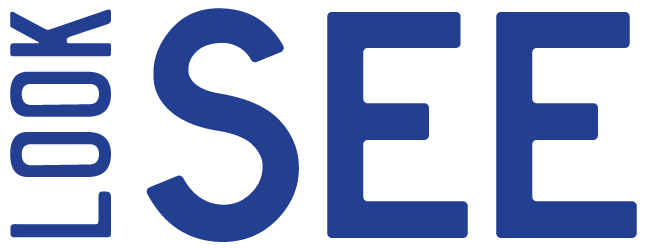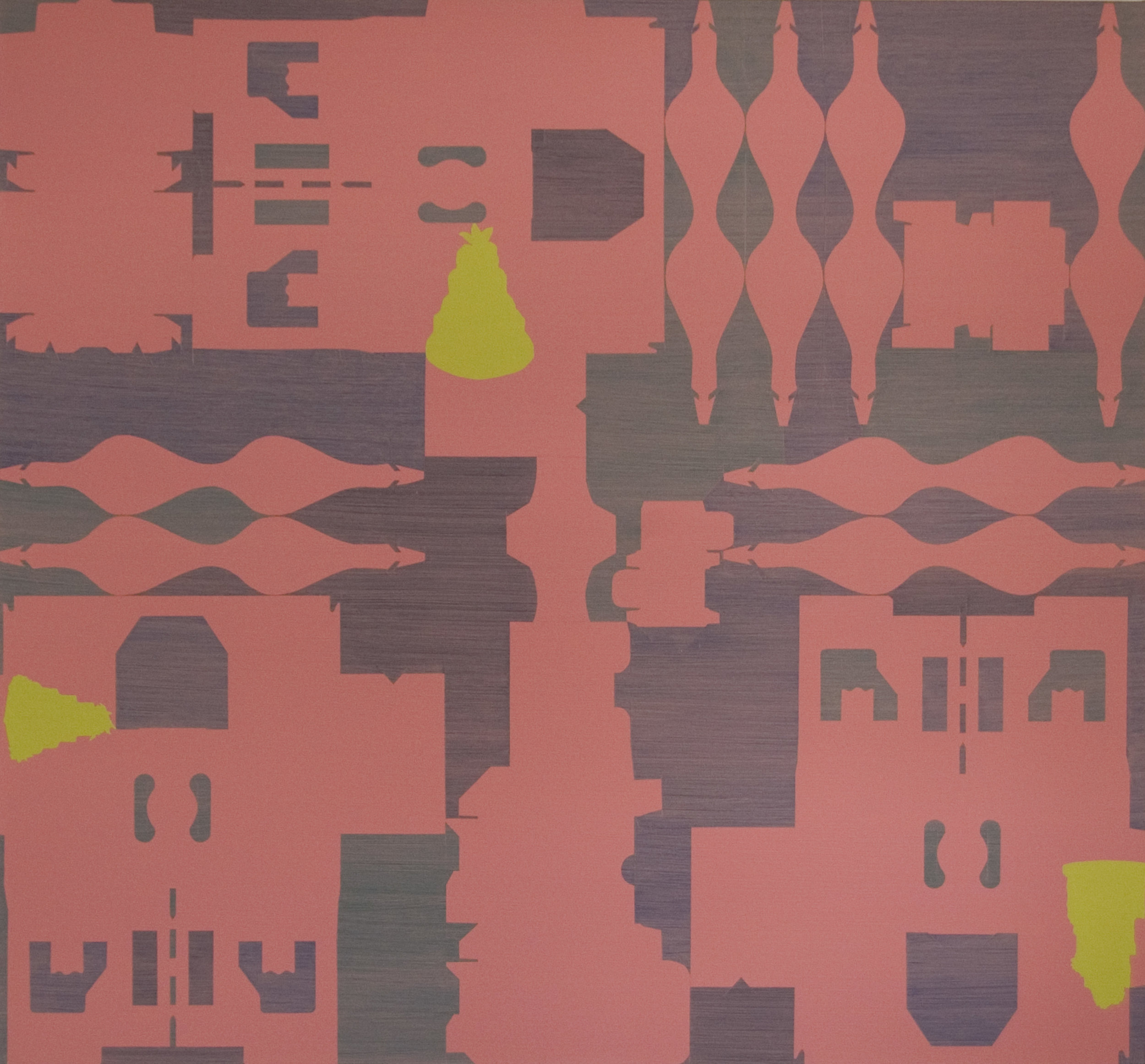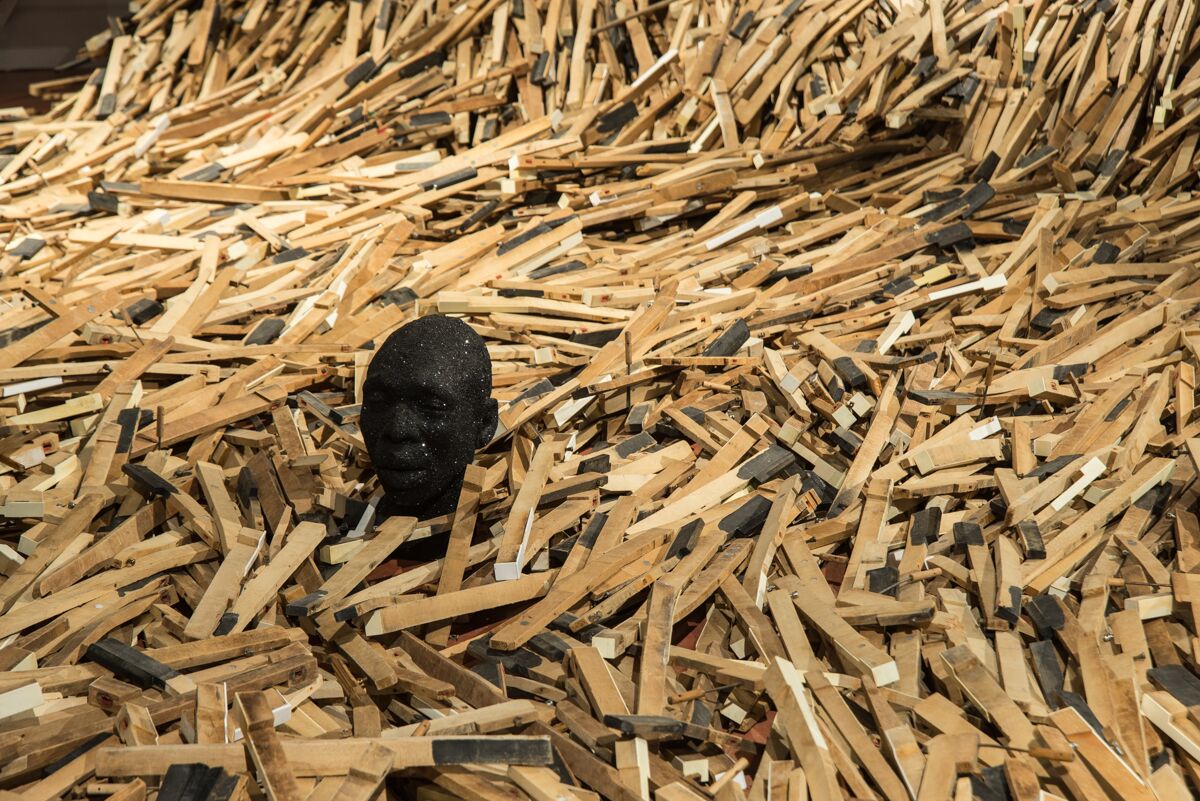LookCLOSE: Paul Ryan: Conveyor

by Matt Shelton | January 30, 2019
Paul Ryan, see if you agree, 2015, oil and acrylic on canvas, 64" x 90".
Image courtesy of the artist and Reynolds Gallery. Image copyright Paul Ryan.
Part I
I know my words are boxes…and i know my words are box-cutters.
❧Tim Kinsella
When I first met Paul: I was so delighted to have a space to talk about ethics and politics and art at the same time. Paul was my theory teacher in grad school at VCU. Paul is another person (like Jeff Jeske [RIP], Betsy Brown, David Newton [RIP], Lisi Raskin, Holly Morrison, Clyde Fowler [RIP], Carolyn Beard Whitlow) who encouraged me to take long, steady, deep dives into the material, to develop my focus, to handle each word, each phrase, with the intensity and economy of a poet. I should try to be free in writing this, as though I am writing one of those grad school emails to Paul. Let my excitement, my questions, pull me along. Paul values time, deep consideration, and reflection; he values making meaning together—in dialogue, asking questions together of values.
His work is abstract because of his personal, deeply political commitment. He’s a believer in embodying one’s beliefs. The work is not a manifesto or an anthem. It is anti-anthemic, a dispersion of meaning. As Paul Chan said in an interview in BOMB Magazine in July 2005, politics centralizes power, art disperses it.
Paul positions himself as existing within an unjust world. Everything is sharp, but nothing is clear. His work is work to read, like reading a doctor’s handwriting or a poorly translated assembly instructions, like reading the Terms and Conditions or User Agreement for a new credit card. His paintings are so…demanding!
Bite the hand that reads. Paul’s paintings are like gazing at a drawer full of obsolete phone charger cords—but in a good way! The laser-cut shapes of the unfolded packages—their algorithms, his rhythm.
Philip Guston’s meaty canvases throbbed with the sting of a skinned knee or hammered thumb—an injury incurred through carelessness, soon forgotten. The tears of a klutz. But there is something evil under review, conveyed not through the tendered signifiers of Nixon’s phallic nose or the Klansman’s darned hood, but through the smog-like density of mucusy, polluted negative space. Guston conveys a sort of toxicity through the muddied pink atmosphere—what is indecent is less visible, something more inhabited than elected.
Whereas his hero explored corruption through the metaphor of moral and aesthetic impurity, Paul’s paintings reflect the ethical dilemmas of a time characterized by the merger of contact and commerce as evidenced by a pursuit of haptic agreement—frictionless interaction. A world without the speed bumps of eye contact, land lines, layaway. We want noiseless feedback. How can we make the system more deliciously navigable? The ecstasy of participation.
We want a clearer signal, a smoother scroll. We want an end to buffering. We want to experience waitlessness. BORE IS OVER! (If you want it).
Paul Ryan, scanblock, 2014, oil and acrylic on linen, 36" x 36".
Image courtesy of the artist and Reynolds Gallery. Image copyright Paul Ryan.
We need this restlessness not to get closer to anything, but to get farther from what we experience most closely: ourselves. Our feeds keep us full. If the static is dense enough, you simply don’t have the bandwidth to address the wildfires, the caravans, the grabby lechers, the trolls, the indignation, the lies, the lies, the lies thick as a fog of flies on roadkill—the deer mesmerized by a horizon surging with luminous annihilation.
PART II
Eventually the dying man takes his final breath
But first checks his news feed to see what he's 'bout to miss
And it occurs to him a little late in the game
We leave as clueless as we came
From rented heavens to the shadows in the cave
We'll all be wrong someday.
❧ from Father John Misty’s Ballad of the Dying Man
Paul is trying to stay sad. These are not hopeful paintings. His paintings are like the flattened contents of a butterfly net. He is sad that we have succumbed to our appetite for distraction. The marketers figured out they need not package happiness so much as subscriptions to a stream of unbroken diversion. If every interstice is plugged with information, we won’t have time to consider the evidence that we are, in fact, fucked.
Paul Ryan, be sure to ask, 2015, oil and acrylic on canvas, 60" x 72".
Image courtesy of the artist and Reynolds Gallery. Image copyright Paul Ryan.
Thinking about the speed of the paintings: how they hit you almost all at once—with the vivid crisp opacity of a backlit screen. But so graphic and flat. Value is only denoted through color choice. It is never representational or descriptive of mass or form. It’s almost like the design elements are on different tracks, just overlaid on top of one another. Like a DJ as opposed to a live band. We have the rhythm here, and the color here, and the shape here.
His work explores the notion of bewildered compliance in a number of ways—from the drained palette, to the dry humor of the titles (repurposing the cloying, coercive effect of clickbait marketing: “See if you agree!”), to the precision—the resoluteness—of the masking in figure-ground relationships.
Paul Ryan, reliever...reducer, 2014, oil and acrylic on linen, 36" x 36".
Image courtesy of the artist and Reynolds Gallery. Image copyright Paul Ryan.
His paintings speak like wrapping paper—that same pop constitution/orientation. Eye-catching, pleasurable, fun. Like a party! Play! The paintings actually look printed; there’s a sense that the actual construction is just a matter of execution—in a Minimalist, LeWittian sense—even as the discipline of the technician/artisan’s hand is also foregrounded.
But there is evidence of “The Hand,” too—the intricacies of the masking—cutting away. How’s your arthritis/carpal tunnel, Paul? This intricacy plays against the speed of the translucent painting in the negative shapes, but even that, too, is uniform in application, a thin veil, a scrim. Almost gauzy—like a bandage, something wrapped. Of course, the hand that plays with shadows is also the hand that designs the packaging and the machine.
Paul Ryan, small indulgences, 2015, oil and acrylic on canvas, 50" x 54".
Image courtesy of the artist and Reynolds Gallery. Image copyright Paul Ryan.
There are three types of shapes in Paul’s most recent painting, a number of factors (2018): unfolded packages, bleached coral shapes, and negative shapes. This is an inversion of industrial design. The 3-D packages are unclasped, unfolded, “deconstructed,” the arrangement of four vertically-stacked short and wide canvases reads like a colorful musical score. It has the look of a digital interface of editing software for time-based media, but also calls to mind the scrolling backdrop of animation—of video games in particular. Ryan shares Cory Arcangel’s Warhol crush, and looking at his work, it’s hard not to imagine that the background for Super Mario Clouds (2002) has been unfurled and composited into a single image.
Paul Ryan, a number of factors, 2018, oil and acrylic on canvas, 51" x 90".
Image courtesy of the artist and Reynolds Gallery. Image copyright Paul Ryan.
It’s a play on Warhol and a play on the post-impressionistic still life, too. If we think of Cezanne’s apple compositions as using the still life as a vessel for enacting his more abstract vision, as a pretext for painting a field of asymmetrical ellipses, we could see Paul’s paintings as a post-industrial closing bracket to Cezanne’s table. Here, the items are smushed as on a scanner bed, as being fed through a great disintegration machine.
It really invites so much comparison to schematic imagery: it is a floor plan (“<—You are here” in relation to the nearest fire escape) but also a cross-section. Like a voyeur peering at the building across the street, we see the drama unfolding on each of the floors. From this vantage point, one sees a matrix of sameness, but of course, on close inspection, every square centimeter is exhaustingly solitary in its proprietary novelty. Surveillance, too, comes up in the potential for the piece to read as a series of conveyor belts, particularly those of an airport—our luggage offering the same sense of the limited bandwidth given to accommodating radical difference in our culture. Our products are designed with distribution in mind. Paul’s painting alludes to the ritual fetish of unboxing, but his attention is fixed on the packaging, not the objects the package delivers. Only occasionally do I find myself wondering what kind of consumer good produced any particular rectilinear cluster. Instead, I get stuck playing an image game reminiscent of a click-bait IQ test: Which figure logically belongs in the blank space?
There is a sense that things are in motion but rarely going anywhere. There’s a lot of traffic. A lot of coming and going. Hopping shapes across a five-lane freeway is a perilous hustle. If the layout of the unfolded boxes represents a “labyrinthine structure,” then that bodes poorly for the coral shapes. There is no room to move, no possible navigation. Not even when traveling within the “machinery.” It’s gridlock.
Paul Ryan, meet or exceed, 2015, oil and acrylic on canvas, 50" x 54".
Image courtesy of the artist and Reynolds Gallery. Image copyright Paul Ryan.
Paul Ryan, no matter how hard you try, 2015, oil and acrylic on canvas, 50" x 54".
Image courtesy of the artist and Reynolds Gallery. Image copyright Paul Ryan.
Paul’s painting is actually not cathartic, but cathectic. The notion of the investigative tools of the enlightenment being used to describe the ambivalence of one who feels trapped in their own place within the gears of a self-destructive society feels like a meticulous collapse, something folding in on itself. I find it depressing…and I believe that is the strength or rigor of the work. In this way, I find myself thinking about sculptors like Roxy Paine and Haim Steinbach. Their practices suggest a preoccupation with a culture that, if forced to choose, would select order over nature, the banal over the ugly, shallow complexity over deep simplicity.
Do you find your finished works depressing, Paul? Or is there some release for you, some unlocking or shedding of a burden, that occurs for you in the process that makes the affective experience redemptive of the content? And do you anticipate that the affective experience of the viewer will also transcend the content? What do you want from your work? It would be strange if someone so keenly attuned to and upset about the smothering and insidious ubiquity of consumer “culture” did not want some kind of “transformation.”
This essay was commissioned as the catalogue essay for the dual-venue exhibition In Dialogue: Paul Ryan, Paintings 1985-2018, on view at Mary Baldwin University's Hunt Gallery through February 7 and at the Staunton Augusta Art Center galleries through February 9.
Banner image: Paul Ryan, detail, no waiting between batches, 2015, 12" x 90". Image courtesy of the artist and Reynolds Gallery. Image copyright Paul Ryan.
Matt Shelton received his BFA in Studio Art from Guilford College and his MFA in Painting and Printmaking from Virginia Commonwealth University. His criticism has been featured in Art Papers, Ext. 1708, and Richmond Arts Review. He teaches drawing, painting and time-based media at Virginia Commonwealth University and the University of Virginia. He lives with his family outside Charlottesville.













